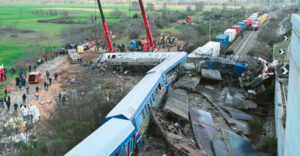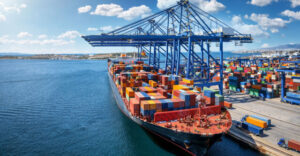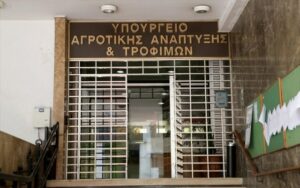With new data from the commercial train videos filed with the Justice Department, the National Air and Rail Accident Investigation and Transportation Safety Agency (NACA) is expected to release on February 27 the result on the causes of the Tempi accident, although it will also examine what has changed in Greek rail two years after the tragedy. The conclusion, which is presented in detail by protothema.gr, will not be particularly pleasant for anyone concerned. Of course, it will not only concern the big fire that occurred after the collision between the passenger train and the freight train late on the evening of February 28, 2023, but it will also evaluate what happened that led to this tragedy.
It has taken some time to complete the Agency’s conclusion, which is expected to be a catalyst for wider developments. The head of the Agency’s rail arm, the experienced lawyer Christos Papadimitriou, worked with executives of the European Railway Agency (ERA) who came to the country, following a communication between the government and the Commission, in order to investigate essentially what went wrong that night, but also before the collision, and of course to point out what needs to be changed in the Greek railway. As a general conclusion of the report it could be said that, everything went wrong and everything has to change, as so far few steps have been taken towards that direction.
For several months Mr Papadimitriou along with Bart Aku, the No 2 of the ERA, and his task force visited the sites of the tragedy: the Larissa railway station, the disputed station house, the site of the tragedy in Tempe, the Thessaloniki freight station and so on. They talked to over 80 people and only one refused to talk to them: the accused stationmaster Vassilis Samaras, who was recently released from jail pending trial as his pre-trial detention period came to an end. The finding outlines what went wrong that night, what had gone wrong up to that point, what has changed or not changed since, and makes recommendations to OSE, Hellenic Train, Railway Regulatory Authority, Commission and ERA, and to the Ministry of Transport itself, which is the lead authority.
The fatal mistakes
“The tragic and unacceptable aspect of the case is that the two trains entered the same line,” a competent source say, commenting on the latest developments concerning the freight train’s cargo that ignited after the collision and apparently caused deaths.
Agency officials return to the fateful night for the country, in the middle of the three-day Clean Monday weekend, when the inexperienced and virtually untrained stationmaster Vassilis Samaras is left alone in the station house, while by standard practice there are two stationmasters on duty. The finding reviews the stationmaster’s movements throughout the previous days and assesses his training as deficient.
Indeed, other witnesses describe the Larissa station as the third most difficult to manage, after those in Athens and Thessaloniki. And while night shifts tend to be more “relaxed”, that night’s shift was turning into a nightmare. Based on the findings, Samaras appears overwhelmed. He has to deal with train delays and protesting passengers who open the station door and talk to him.
90 communications in one hour
It is telling that in one hour he makes 90 radio communications, which is not common. He makes a mistake and puts the local Larissa commuter train 2597 on the wrong line, until the train driver realizes it. The intercoms exacerbate the stress of the inexperienced stationmaster, who has commonly “dropped the ball”. In fact, the way the stationmaster is structured, he has the keys on him and he makes radio communications by looking ahead. As a result, he doesn’t turn the keys and the passenger train gets on the wrong line.
The experts also find several protocol violations here, resulting in the two trains running on the same line for 5.5 kilometers.
The experienced driver of the passenger train Giorgos Koutsoumbas, who has also made the downward route from Thessaloniki and has been delayed, is trying to make up time. He is having problems with his health as he had suffered a mild stroke, but that doesn’t stop him from driving. He is considered experienced but authoritarian. He leaves Larissa station without getting the so-called ‘telegram 1001’, i.e. that he is going in the wrong direction. And he himself does not repeat word for word the message he hears the stationmaster Samaras address to him over the radio. But neither does he communicate with the stationmaster when he reaches the “key” and actually enters the reverse line. The rest is history.
The load and the videos
Over the past two months, ERA experts have been thoroughly investigating the explosion that caused the big fireball. The Europeans had reportedly shown the videos to several experts without getting a convincing answer. What certainly had not been taken into account by the experts who drew up the conclusion was the new videos submitted to the appellate investigator by lawyer Vassilis Kapernaros depicting the path of the freight train, which show no tank that could have contained solvents on the first platforms after the engine. The authenticity of the videos will be verified, although competent sources believe it is unlikely that doctored videos were downloaded at this stage. In any case, according to reports, the NACA will demand that the investigator get hold of the footage in his hands, even before the authenticity assessment is completed. And it remains to be seen whether this process can affect the timing of the finding – even if it does not relate solely to the fire.
However, up until the appearance of the videos, the University of Pisa advises that the Computational Fluid Dynamics (CFD) method could be used to draw conclusions. This follows the commissioning of the University of Ghent to define the parameters of the model. Based on sampling from the tragedy site several days after the accident and with available videos of the collision, the conclusion the scientists are led to is that this explosion seems impossible to have resulted from silicone oil as the fire brigade states in its conclusion. Based also on the research of the Rice Institute in Stockholm, for silicone oils to produce this fire, they would have had to have been incandescent at 400°C and the transformers would have been damaged or deeply cracked. Scientists estimate that the material that was incandescent reached 200°-250°C and the transformers are intact. All these findings lead to the conclusion of aromatic hydrocarbons.
Instructions
According to the finding, it is obvious that if the famous Convention 717 had been completed and there was an automatic braking system on trains at the same time, the accident would not have happened. The authors of the report, however, do not go into further detail as to the non-execution of the contract in question, as that was not the question they were asked to answer.
More critically, however, the finding comes down to the conclusion that two years on, little has changed to correct the structural flaws in Greek railways. And with this in mind, EDOASAM is issuing a series of fire instructions to the organisations involved.
For Hellenic Train, which has so far taken virtually no responsibility, it is stressed that it should develop a system to record and process intercommunications, something it has not done so far. It is called upon to apply disciplinary sanctions, unlike today, but also to develop a system to control the loading of wagons, as even today this does not exist. For the OSE things are even worse. It is described as a highly understaffed organisation with almost 2,200 (2,184) posts on its organisational chart, of which 589 are filled. In practice, the OSE is operating at 25 % of its appropriate capacity. It is called upon to better understand the risks associated with its operation by carrying out systematic maintenance rather than repairs to its infrastructure. It is called upon to make a long-term plan for safety and renewal of the line, and a manual for overseeing those who have a role in railway safety. At the same time, it is being asked to develop a more specific system of evaluation and training for those with critical tasks, such as station masters and lockers. It is also noted that the station masters are wrongly structured, with the board on the station masters’ backs, and it is considered that it is wrong to have a 160 km/h limit on the whole network when the condition of the line is not taken into account. “In Germany, in places without telecommunications, the maximum speed limit is 80 km/h,” it says.
GSMR urgently
For the OSE, however, the NACA’s remarks have the character of urgency. More specifically, in June the agency called on the OSE to immediately deploy a GSMPR system to allow trains to communicate directly with each other. There was a commitment from the OSE that by December the system would be developed and operational. It is now February and it does not appear that the system will be operational immediately and in any case within the first quarter of 2025, as sources at GAOSE said some time ago.
As for the Railways Regulatory Authority, the finding says it should set up a system to monitor all critical safety incidents primarily and then assess them and issue recommendations. It should also do more inspections and audits. Of course, everyone acknowledges that the RAS is understaffed. The Department of Transportation is urged to immediately address the staffing issues of both the RAS and the OSE.
The warnings, meanwhile, are also addressed to Europe, with recommendations to the Commission and ERA to strengthen oversight of the OSE and RAS respectively, as it is clear that the European control framework has also been very lax and allowed for mismanagement of funds linked to the implementation of critical infrastructure on the safety side.
Ask me anything
Explore related questions





